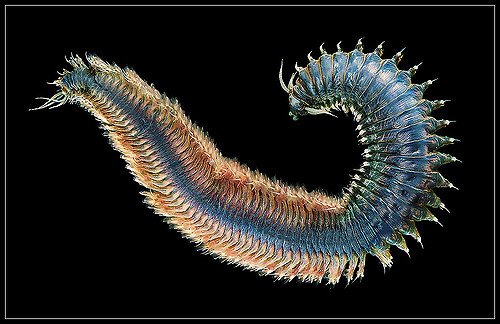Scientists have discovered something interesting regarding modern annelids. Actually, they possibly originated from tiny worms with hundreds of bristles and two tentacles coming out of its head. These worms also didn’t have any eyes and possibly lived under the water more than 500 million years ago. The remains of this bristle worm have been discovered in British Columbia, Canada.
A research team with the Royal Ontario Museum analyzed a perfectly preserved fossil of a worm that measures only 2 centimeters. The rare bristle worm was found along with the other 20,000 animal remains which were uncovered from the Burgess Shale at Kootenay National Park, British Columbia in 2012, 2014 and 2016.
Thanks to such a large amount of evidence, scientists documented an underwater landslide which had buried and killed prehistoric creatures, according to the explanation of University of Toronto and ROM researcher Karma Nanglu. The small bristle worm is one of 500 of those which were fossilized on the seafloor that belong to a new species. Compared to vertebrates, exoskeletons, and shells, the fossil of this worm is considered a significant find, thanks to the uncommon appearance of the animal.
“You need to look to truly exceptional fossil deposits like those found in the Burgess Shale to find well-preserved body fossils. Even then, they are quite uncommon and many of the currently described species there are still poorly understood,” Jean Bernard Caron, senior curator of invertebrate paleontology at the ROM said in a statement.
“While the diversity of annelids in terms of their anatomies and lifestyles makes them ecologically important and an evolutionarily interesting group to study, it also makes it difficult to piece together what the ancestral annelid may have looked like,” lead author Karma Nanglu, a PhD candidate in the Department of Ecology & Evolutionary Biology in the Faculty of Arts & Science at University of Toronto, and a researcher at the Royal Ontario Museum, said in the statement.
When the researchers were examining the discovered fossil, they found that it had soft tissue which made up its body. That will help scientists comprehend the way heads of segmented worms evolved. Even though similar fossils were discovered in Greenland, Nanglu said that they are not as well preserved as the fossils discovered in Canada, as they can see the body of the animal more clearly and have a better picture of the head’s structure.
The tiny bristle worm had two tentacles attached to its head, which are called palps. Palps helped the species feel the ground that they were moving on. According to the scientists, those animals still lived during the Precambrian Era. They believe it lived on the ocean floor and fed on organic material. According to the statement, the discovered species are associated with modern earthworms and leeches with similar physical features.
Also, according to the worm’s remains, the small animal didn’t only have bristles on its body, they were also located on a part of its head, specifically they were present on an area which is near its mouth. This discovery is special, as it will support the analyzing of modern animal diversity, but also unique morphologies.
According to the statement, findings on this study will be published today in Current Biology.





